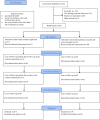Sealing versus partial caries removal in primary molars: a randomized clinical trial
- PMID: 24884684
- PMCID: PMC4045925
- DOI: 10.1186/1472-6831-14-58
Sealing versus partial caries removal in primary molars: a randomized clinical trial
Abstract
Background: The resin-based pit and fissure sealant is considered a successful tool in caries prevention, however there is a growing evidence of its use in controlling already established caries in posterior teeth. The aim of this clinical trial is to verify the efficacy of pit and fissure sealants in arresting dentinal caries lesions compared to partial excavation and restorative treatment in primary molar teeth.
Methods: Thirty six patients with occlusal cavitated primary molar reaching outer half of dentin were selected. The patients were randomly allocated into two groups: sealant application (experimental group - n = 17) and restoration with composite resin (control group - n = 19). Clinical and radiograph evaluation were performed after 6, 12 and 18 months. The chi-square test was used to verify the distribution of characteristics variables of the sample among the groups. The survival rate of treatments was evaluated using Kaplan-Meier survival and log-rank test. Fisher's Exact and logistic regression tests were calculated in each evaluation period (α = 5%).
Results: The control group showed significantly better clinical survival after 18 months (p = 0.0025). In both groups, no caries progression was registered on the radiographic evaluations.
Conclusions: Sealing had similar efficacy in the arrestment of caries progression of cavitated occlusal lesions compared to partial excavation of the lesions, even though the frequency of re-treatments was significantly higher in sealed lesions.
Trial registration: Registro Brasileiro de Ensaios Clínicos (ReBEC): RBR-9kkv53.
Figures
Similar articles
-
Sealing occlusal caries lesions in adults referred for restorative treatment: 2-3 years of follow-up.Clin Oral Investig. 2012 Apr;16(2):521-9. doi: 10.1007/s00784-011-0549-4. Epub 2011 Apr 9. Clin Oral Investig. 2012. PMID: 21479565 Clinical Trial.
-
Randomized clinical trial of adhesive restorations in primary molars. 18-month results.Am J Dent. 2013 Dec;26(6):351-5. Am J Dent. 2013. PMID: 24640441 Clinical Trial.
-
Efficacy of sealing occlusal caries with a flowable composite in primary molars: A 2-year randomized controlled clinical trial.J Dent. 2018 Jul;74:49-55. doi: 10.1016/j.jdent.2018.05.014. Epub 2018 May 22. J Dent. 2018. PMID: 29800637 Clinical Trial.
-
ARE PIT AND FISSURE SEALANTS EFFECTIVE IN PREVENTING AND ARRESTING OCCLUSAL CARIES IN PRIMARY AND PERMANENT TEETH? AN OVERVIEW OF SYSTEMATIC REVIEWS.J Evid Based Dent Pract. 2024 Sep;24(3):102010. doi: 10.1016/j.jebdp.2024.102010. Epub 2024 May 22. J Evid Based Dent Pract. 2024. PMID: 39174168 Review.
-
Caries detection and diagnosis, sealants and management of the possibly carious fissure.Br Dent J. 2013 Jun;214(11):551-7. doi: 10.1038/sj.bdj.2013.525. Br Dent J. 2013. PMID: 23744208 Review.
Cited by
-
Best-practice prevention alone or with conventional or biological caries management for 3- to 7-year-olds: the FiCTION three-arm RCT.Health Technol Assess. 2020 Jan;24(1):1-174. doi: 10.3310/hta24010. Health Technol Assess. 2020. PMID: 31928611 Free PMC article. Clinical Trial.
-
Atraumatic Restorative Treatment compared to the Hall Technique for occluso-proximal cavities in primary molars: study protocol for a randomized controlled trial.Trials. 2016 Mar 31;17:169. doi: 10.1186/s13063-016-1270-z. Trials. 2016. PMID: 27029801 Free PMC article. Clinical Trial.
-
Selective vs stepwise removal of deep carious lesions in primary molars: 24 months follow-up from a randomized controlled trial.Clin Oral Investig. 2021 Feb;25(2):645-652. doi: 10.1007/s00784-020-03536-6. Epub 2020 Aug 28. Clin Oral Investig. 2021. PMID: 32857210 Free PMC article. Clinical Trial.
-
Future Perspectives in Pediatric Dentistry: Where are We Now and where are We Heading?Int J Clin Pediatr Dent. 2022 Nov-Dec;15(6):793-797. doi: 10.5005/jp-journals-10005-2475. Int J Clin Pediatr Dent. 2022. PMID: 36866132 Free PMC article. Review.
-
Evaluation of the re-mineralization capacity of a gold nanoparticle-based dental varnish: An in vitro study.J Conserv Dent. 2020 Jul-Aug;23(4):390-394. doi: 10.4103/JCD.JCD_315_20. Epub 2021 Jan 16. J Conserv Dent. 2020. PMID: 33623242 Free PMC article.
References
-
- Beauchamp J, Caufield PW, Crall JJ, Donly K, Feigal R, Gooch B, Ismail A, Kohn W, Siegal M, Simonsen R. Evidence-based clinical recommendations for the use of pit-and-fissure sealants: a report of the American Dental Association Council on Scientific Affairs. J Am Dent Assoc. 2008;139:257–268. doi: 10.14219/jada.archive.2008.0155. - DOI - PubMed
-
- Azarpazhooh A, Main PA. Pit and fissure sealants in the prevention of dental caries in children and adolescents: a systematic review. J Can Dent Assoc. 2008;74:171–177. - PubMed
Publication types
MeSH terms
Substances
LinkOut - more resources
Full Text Sources
Other Literature Sources
Medical



